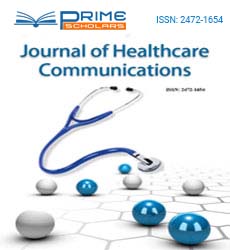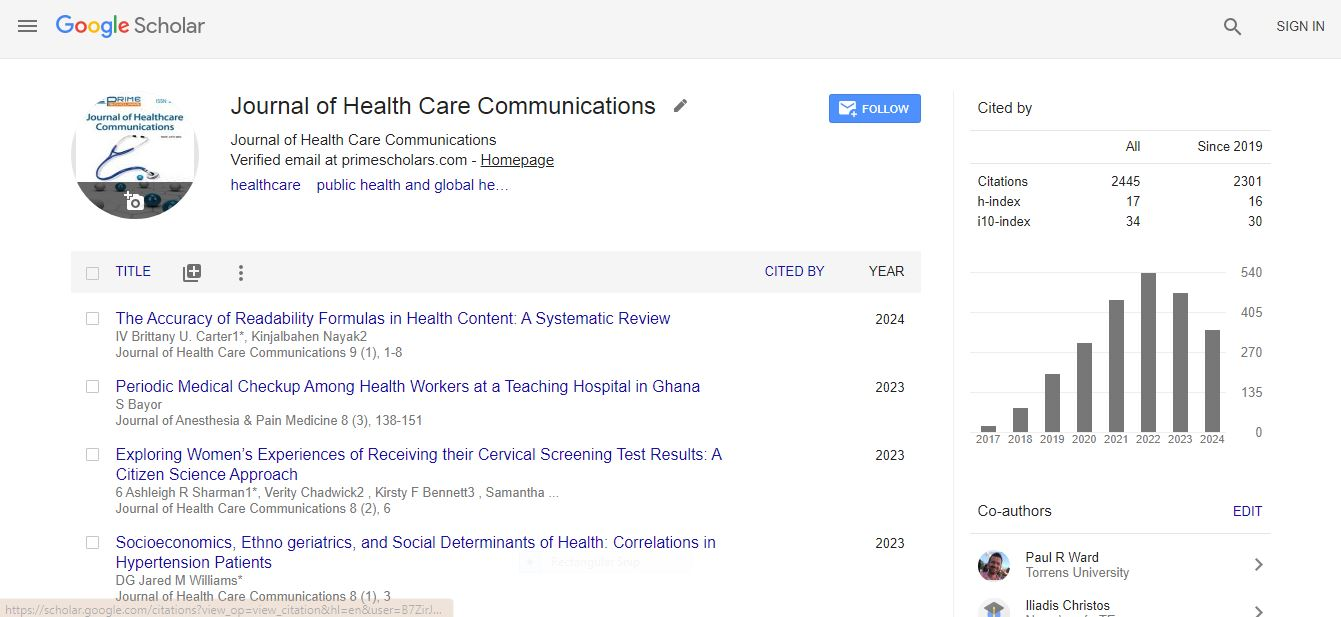Opinion Article - (2025) Volume 10, Issue 2
Healthcare Policies: Communication Pathways for Public Trust and Compliance
Fredrick Dawson*
Department Medicine, UCAM Catholic University of Murcia, Murcia, Spain
*Correspondence:
Fredrick Dawson, Department Medicine, UCAM Catholic University of Murcia, Murcia,
Spain,
Email:
Received: 03-Jun-2025, Manuscript No. IPJHCC-25-22776;
Editor assigned: 05-Jun-2025, Pre QC No. IPJHCC-25-22776 (PQ);
Reviewed: 19-Jun-2025, QC No. IPJHCC-25-22776;
Revised: 26-Jun-2025, Manuscript No. IPJHCC-25-22776 (R);
Published:
03-Jul-2025, DOI: 10.36846/2472-1654.25.10.69
Description
Malpractice risk refers to the possibility of legal claims against healthcare providers for perceived negligence, misdiagnosis, or inadequate care. While clinical expertise plays a large role in preventing malpractice, communication is often the deciding factor in whether a patient chooses to pursue legal action. Studies have shown that patients who feel listened to, informed and respected are far less likely to sue, even when an adverse outcome occurs. This highlights the central role of communication in managing malpractice risk.
One of the most common sources of malpractice claims is poor communication about diagnoses and treatment plans. When patients are not given adequate information about their condition, treatment options, or possible complications, they may feel misled or excluded from decision-making. Informed consent is more than just a signed document it is an interactive conversation in which the provider ensures the patient understands both benefits and risks. Failure to conduct this process thoroughly can increase the likelihood of legal disputes.
Another significant factor is how errors are disclosed. Medical errors, though often unintentional, can lead to serious consequences for patients. Historically, some providers avoided admitting mistakes out of fear of lawsuits. However, research has shown that transparent disclosure acknowledging the error, apologizing and explaining corrective steps reduces the likelihood of litigation. Patients who feel that providers are honest and accountable are more inclined to accept an apology rather than seek legal action.
Time pressures within healthcare environments also contribute to malpractice risk. Physicians and nurses often manage heavy caseloads, limiting the time available for patient interaction. Brief consultations may result in miscommunication, overlooked details, or patient dissatisfaction. For instance, a patient who misunderstands medication instructions due to a rushed explanation may experience complications, potentially leading to claims of negligence. Training providers in clear communication techniques and encouraging active listening can reduce these risks.
Documentation is another critical element. Clear, accurate and comprehensive medical records not only support continuity of care but also serve as legal protection if disputes arise. Inadequate documentation, such as incomplete notes on patient history or missing details about informed consent, can weaken a provider’s defense in malpractice cases. Effective communication includes ensuring that both verbal discussions and written records are consistent and complete.
Cultural and language differences between providers and patients can also heighten malpractice risk. Misunderstandings related to cultural beliefs, health practices, or language barriers may lead patients to perceive that they received inadequate care. Healthcare institutions can reduce this risk by offering interpreter services, training staff in cultural sensitivity and creating patient education materials in multiple languages. These efforts not only improve patient satisfaction but also lower the likelihood of legal disputes.
Team communication within healthcare settings is another factor. Many malpractice cases involve not just individual providers but also systemic failures in teamwork. For example, if a nurse fails to communicate a patient’s symptoms to a physician and this leads to a delayed diagnosis, both the individual and the institution may face liability. Standardized tools such as handoff protocols, checklists and interdisciplinary briefings help ensure that vital information is not lost during transitions of care.
Technology has introduced new dimensions to malpractice risk. Electronic Health Records (EHRs) and telemedicine platforms offer opportunities for improved documentation and communication, but they also present challenges. Misfiled digital data, system errors, or unclear teleconsultation guidelines can create grounds for claims. Providers must be trained to use these technologies effectively while maintaining patient confidentiality and clarity in digital communications.
Patient expectations play a large role as well. In modern healthcare, patients often access information online before visiting a provider. If their expectations, shaped by online sources, do not match the medical advice given, they may perceive negligence even when care is appropriate. Providers can manage these expectations through open conversations that clarify misconceptions and explain the reasoning behind treatment choices.
Healthcare institutions have a responsibility to create environments that reduce malpractice risk through better communication. This includes regular training for staff on patient interaction, creating feedback systems where patients can voice concerns before they escalate and establishing support systems for providers who experience malpractice claims. A culture that encourages transparency and learning from mistakes reduces defensive practices and improves patient trust.
Insurance companies that provide malpractice coverage also recognize the role of communication. Some insurers offer premium reductions to providers who participate in communication training programs or adopt patient-centered care models. This reflects the strong evidence that effective communication decreases the frequency and severity of malpractice claims.
Ultimately, malpractice risk is not solely about avoiding lawsuits it is about ensuring patient safety, satisfaction and trust. Effective communication creates a partnership between patients and providers, where decisions are shared, expectations are realistic and errors are addressed with honesty. This proactive approach not only reduces legal risk but also strengthens the overall quality of care.
Conclusion
Malpractice risk in healthcare arises from a variety of factors, but communication is central to its prevention. Informed consent discussions, error disclosures, accurate documentation and culturally sensitive interactions all play vital roles in reducing disputes. At the institutional level, teamwork and technology management further influence malpractice outcomes. By prioritizing transparency, active listening and patient engagement, healthcare providers can protect both themselves and their patients. Effective communication transforms malpractice prevention from a defensive legal strategy into a constructive practice that improves relationships, enhances safety and strengthens the credibility of healthcare systems.
Citation: Dawson F (2025) Healthcare Policies: Communication Pathways for Public Trust and Compliance. J Health Commun. 10:69.
Copyright: © 2025 Dawson F. This is an open-access article distributed under the terms of the Creative Commons Attribution License, which permits unrestricted use, distribution, and reproduction in any medium, provided the original author and source are credited.

